Fuzzy Neural Network-Based Interacting Multiple Model for Multi-Node Target Tracking Algorithm
Abstract
:1. Introduction
2. The FNN–IMM Algorithm of Single Node
- N detection nodes with the same type are present in a WSN, and the detection nodes only have one detection mode.
- Data measured by node detectors are 2D position coordinates of the invasion targets.
- diag(EoR) is used to express the principal diagonal elements of EoR. If diag(EoR) ≈ 0, then R remains unchanged.
- If diag(EoR) > 0, then the corresponding elements of R decrease.
- If diag(EoR) < 0, then the corresponding elements of R increase.
3. Multi-Node Target Tracking Data Fusion Algorithm
3.1. Calculation of Confidence Weight Vector
- All the detection nodes in the network are judged by the system as having poor status at a certain time. The fusion algorithm directly adopts the node data with the lowest average of MSe and MS in Equations (25) and (26).
- The node data are abandoned if the MSe of some nodes is higher than 2. If the MSe values of all the nodes are higher than 2, the algorithm operation stops, and an error is reported.
3.2. Defuzzification Data Infusion
4. Simulation Experiment
4.1. Experiment Description
4.2. Result Analysis
4.2.1. Performance Contrast Experiment of the Single-Node FNN–IMM Algorithm
4.2.2. Performance Verification Experiment of Multi-Node Infusion Algorithm
5. Conclusions
Acknowledgments
Author Contributions
Conflicts of Interest
References
- Yick, J.; Mukherjee, B.; Ghosal, D. Wireless sensor network survey. Comput. Netw. 2008, 52, 2292–2330. [Google Scholar] [CrossRef]
- Messer, H.; Zinevich, A.; Alpert, P. Environmental monitoring by wireless communication networks. Science 2006, 312, 713. [Google Scholar] [CrossRef] [PubMed]
- Viani, F.; Rocca, P.; Oliveri, G.; Trinchero, D.; Massa, A. Localization, tracking, and imaging of targets in wireless sensor networks: An invited review. Radio Sci. 2011. [Google Scholar] [CrossRef]
- Losilla, F.; Garcia-Sanchez, A.-J.; Garcia-Sanchez, F.; Garcia-Haro, J.; Haas, Z.J. A comprehensive approach to WSN-based ITS applications: A survey. Sensors 2011, 11, 10220–10265. [Google Scholar] [CrossRef] [PubMed]
- Albaladejo, C.; Sánchez, P.; Iborra, A.; Soto, F.; López, J.A.; Torres, R. Wireless sensor networks for oceanographic monitoring: A systematic review. Sensors 2010, 10, 6948–6968. [Google Scholar] [CrossRef] [PubMed]
- Read, J.; Achutegui, K.; Miguez, J. A distributed particle filter for nonlinear tracking in wireless sensor networks. Signal Process. 2014, 98, 121–134. [Google Scholar] [CrossRef]
- Zhang, T.; Wu, R. Affinity propagation clustering of measurements for multiple extended target tracking. Sensors 2015, 15, 22646–22659. [Google Scholar] [CrossRef] [PubMed]
- Vasuh, S.; Vaidehi, V. Target tracking using interactive multiple model for wireless sensor network. Inf. Fusion. 2016, 27, 41–53. [Google Scholar] [CrossRef]
- Chu, H.; Wu, C.H. A Kalman framework based mobile node localization in rough environment using wireless sensor network. Int. J. Distrib. Sens. Netw. 2015, 11, 841462. [Google Scholar] [CrossRef]
- Mazor, E.; Averbuch, A.; Bar-Shalom, Y.; Dayan, J. Interacting multiple model methods in target tracking: A survey. IEEE Trans. Aerosp. Elec. Syst. 1998, 34, 103–123. [Google Scholar] [CrossRef]
- Cui, N.; Hong, L.; Layne, J.R. A comparison of nonlinear filtering approaches with an application to ground target tracking. Signal Process. 2005, 85, 1469–1492. [Google Scholar] [CrossRef]
- Blom, H.A.; Bar-Shalom, Y. The interacting multiple model algorithm for systems with Markovian switching coefficients. IEEE Trans. Autom. Control. 1998, 33, 780–783. [Google Scholar] [CrossRef]
- Morelande, M.R.; Garcia-Fernandez, A.F. Analysis of Kalman filter approximations for nonlinear measurements. IEEE Trans. Signal Process. 2013, 66, 5477–5484. [Google Scholar] [CrossRef]
- Escamilla-Ambrosio, P.J.; Mort, N. Multisensor data fusion architecture based on adaptive Kalman filters and fuzzy logic performance assessment. In Proceedings of the Fifth International Conference on Information Fusion, Annapolis, MD, USA, 8–11 July 2002. [CrossRef]
- Barrios, C.; Motai, Y.; Huston, D. Intelligent forecasting using dead reckoning with dynamic errors. IEEE Trans. Ind. Inf. 2015, PP. [Google Scholar] [CrossRef]
- Lee, B.J.; Park, J.B.; Lee, H.J.Y.; Joo, H. Fuzzy-logic-based IMM algorithm for tracking a Manoeuvring. IEE Proc. Radar Sonar Navig. 2005, 152, 16–22. [Google Scholar] [CrossRef]
- Ding, Z.; Leung, H.; Chan, K. Model-set adaptation using a fuzzy Kalman filter. In Proceedings of the International Conference on Information Fusion, Paris, France, 10–13 July 2000. [CrossRef]
- Turkmen, I. IMM fuzzy probabilistic data association algorithm for tracking maneuvering target. Expert Syst. Appl. 2008, 34, 1243–1249. [Google Scholar] [CrossRef]
- Tomohiro, T.; Michio, S. Fuzzy identification of systems and its application to modeling and control. IEEE Trans. SMC 1985, 15, 116–132. [Google Scholar]
- Horikawa, S.; Furuhashi, T.; Uchikawa, Y. On fuzzy modeling using fuzzy neural networks with the back-propagation algorithm. IEEE Trans. Neural Netw. 1992, 3, 801–806. [Google Scholar] [CrossRef] [PubMed]
- Abonyi, J. Fuzzy Model Identification for Control; Birkhäuser: Boston, MA, USA, 2003. [Google Scholar]
- Lughofer, E. Evolving Fuzzy Systems—Methodologies, Advanced Concepts and Applications; Springer Publishing Company, Incorporated: Berlin, Germany, 2011. [Google Scholar]
- Pratama, M.; Anavatti, S.G.; Angelov, P.; Lughofer, E. PANFIS: A novel incremental learning machine. IEEE Trans. Neural Netw. Learn. Syst. 2014, 25, 55–68. [Google Scholar] [CrossRef] [PubMed]
- Jang, J.-S.R. ANFIS: Adaptive-network-based fuzzy inference systems. IEEE Trans. Syst. Man Cybern. 1993, 23, 665–685. [Google Scholar] [CrossRef]
- Mehra, R.K. On the Identification of variances and adoptive Kalman filtering. IEEE Trans. Autom. Control 1970, 15, 75–184. [Google Scholar] [CrossRef]
- Mohamed, A.H.; Shwarz, K.P. Adaptive Kalman filtering for INS/GPS. J. Geodesy 1999, 73, 193–203. [Google Scholar] [CrossRef]
- Wang, Q.; Huang, J. A VB-IMM filter for ADS-B data. In Proceedings of the 12th International Conference on Signal Processing, Hangzhou, China, 19–23 October 2014; pp. 2130–2134.

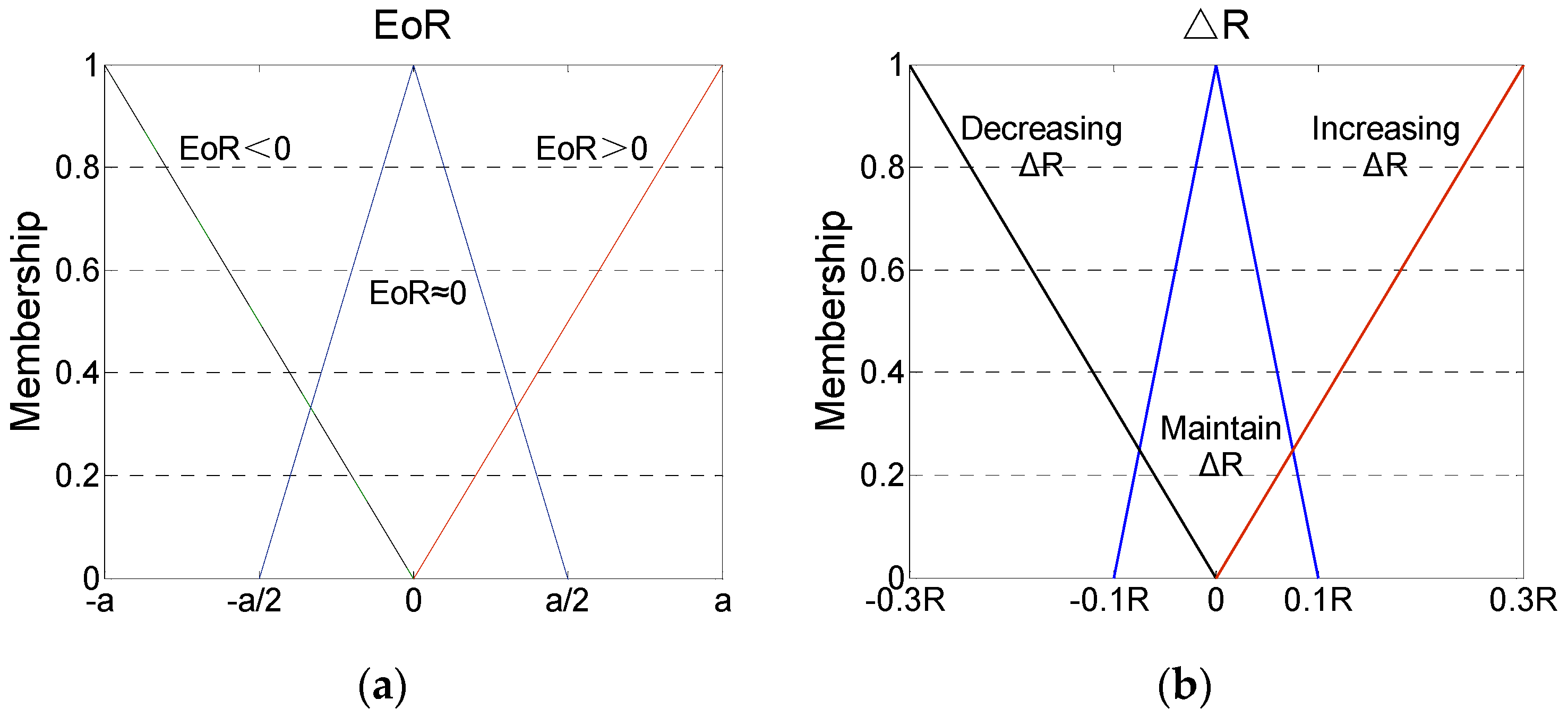

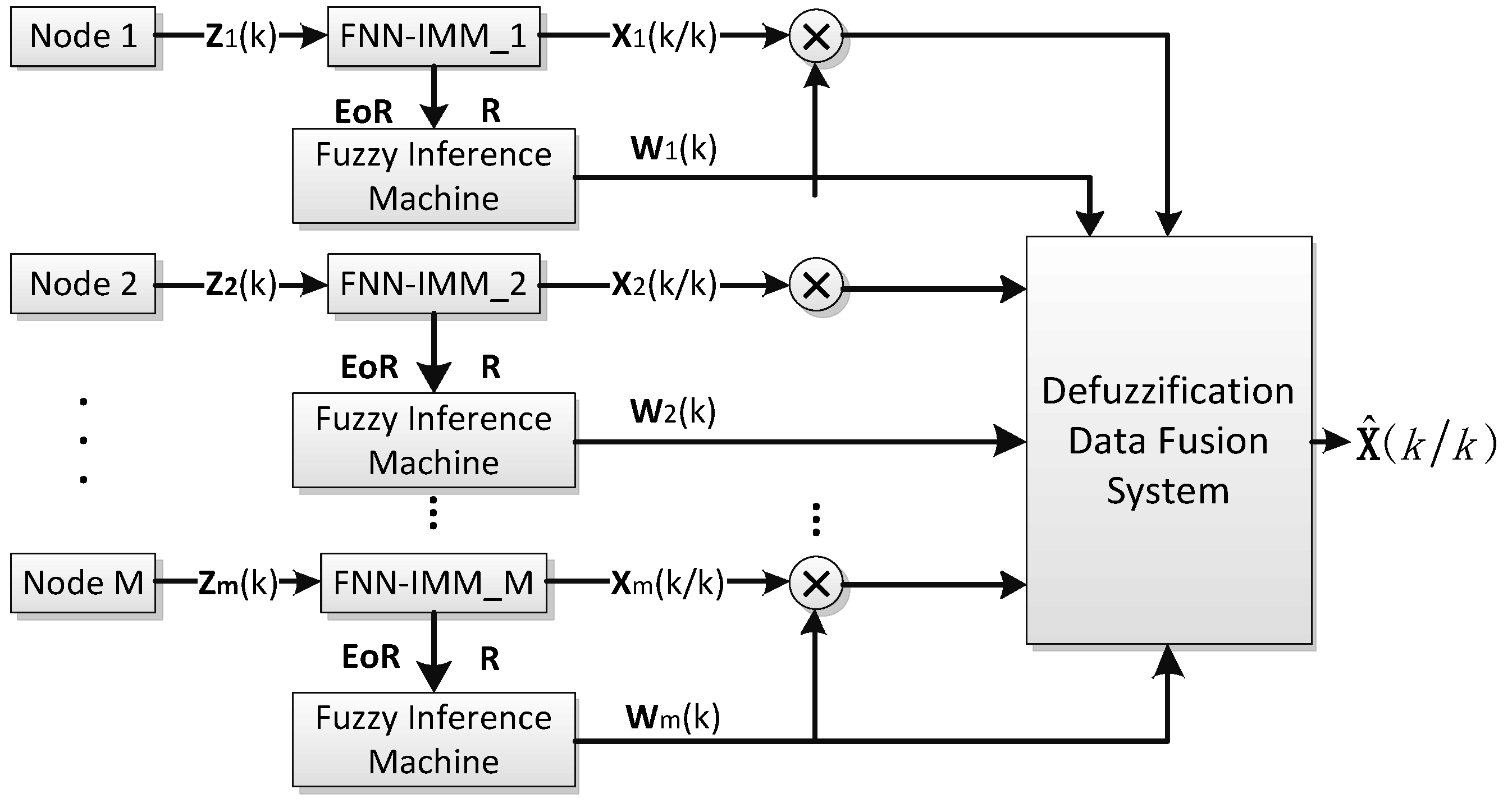
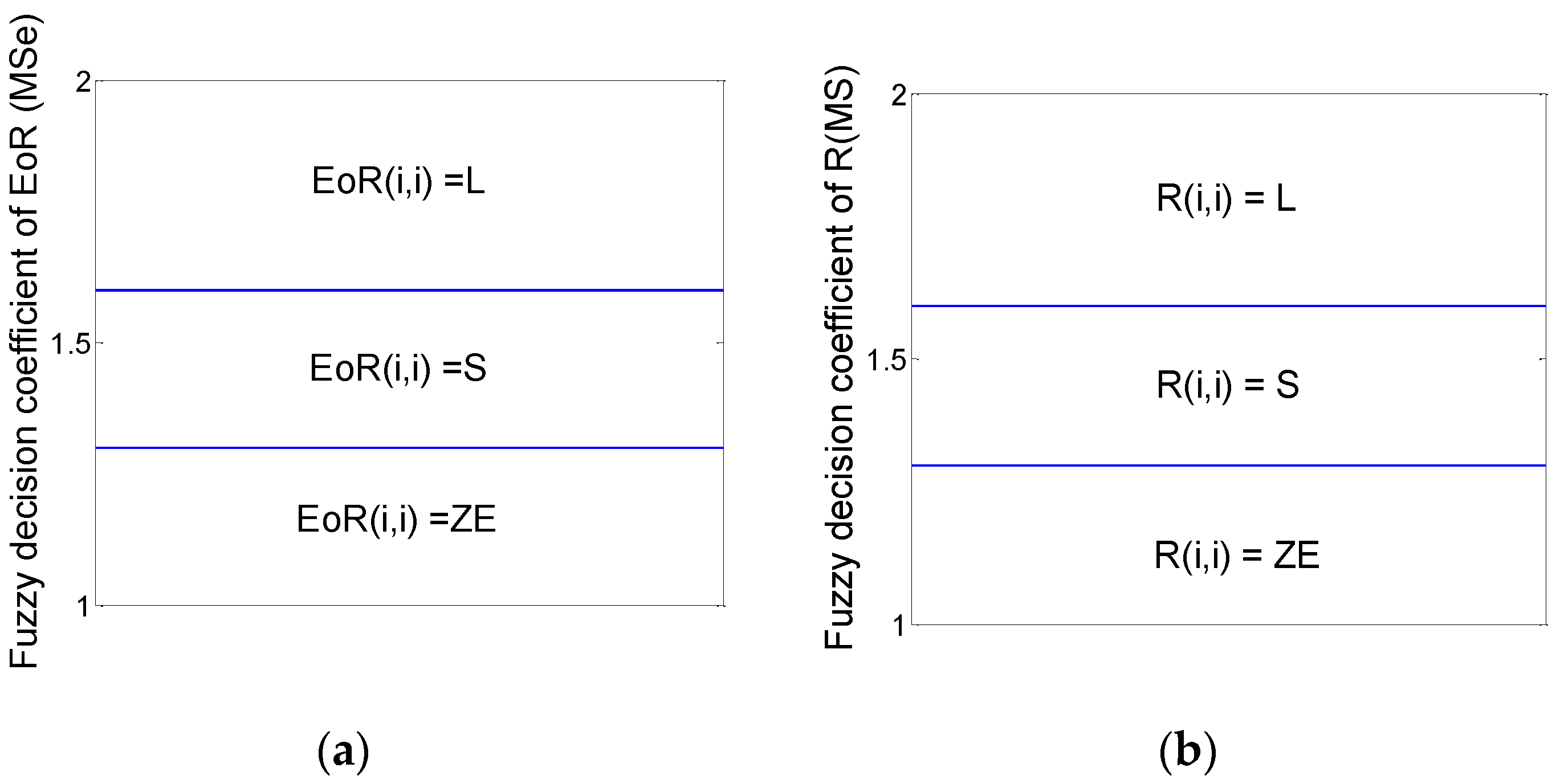

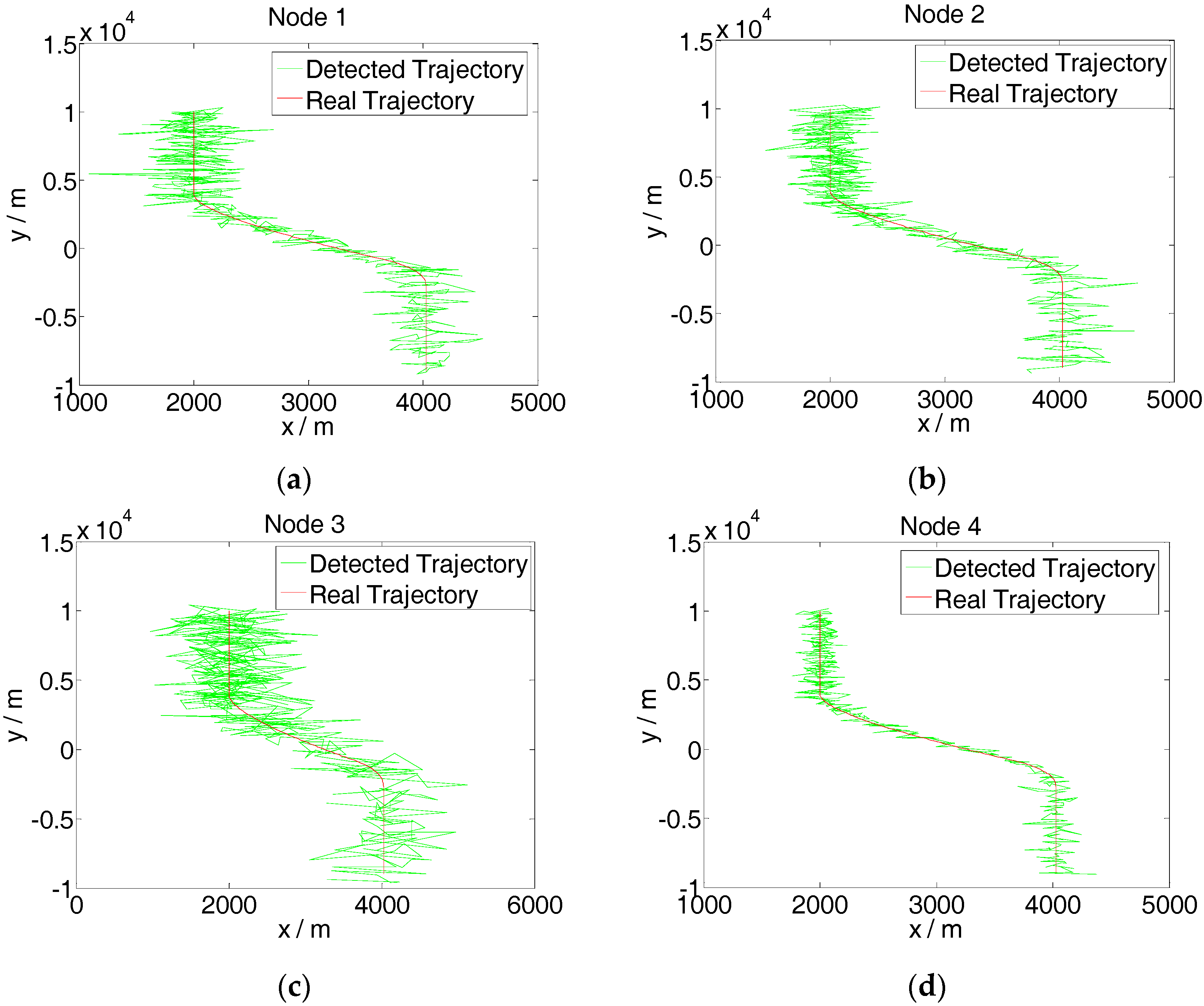


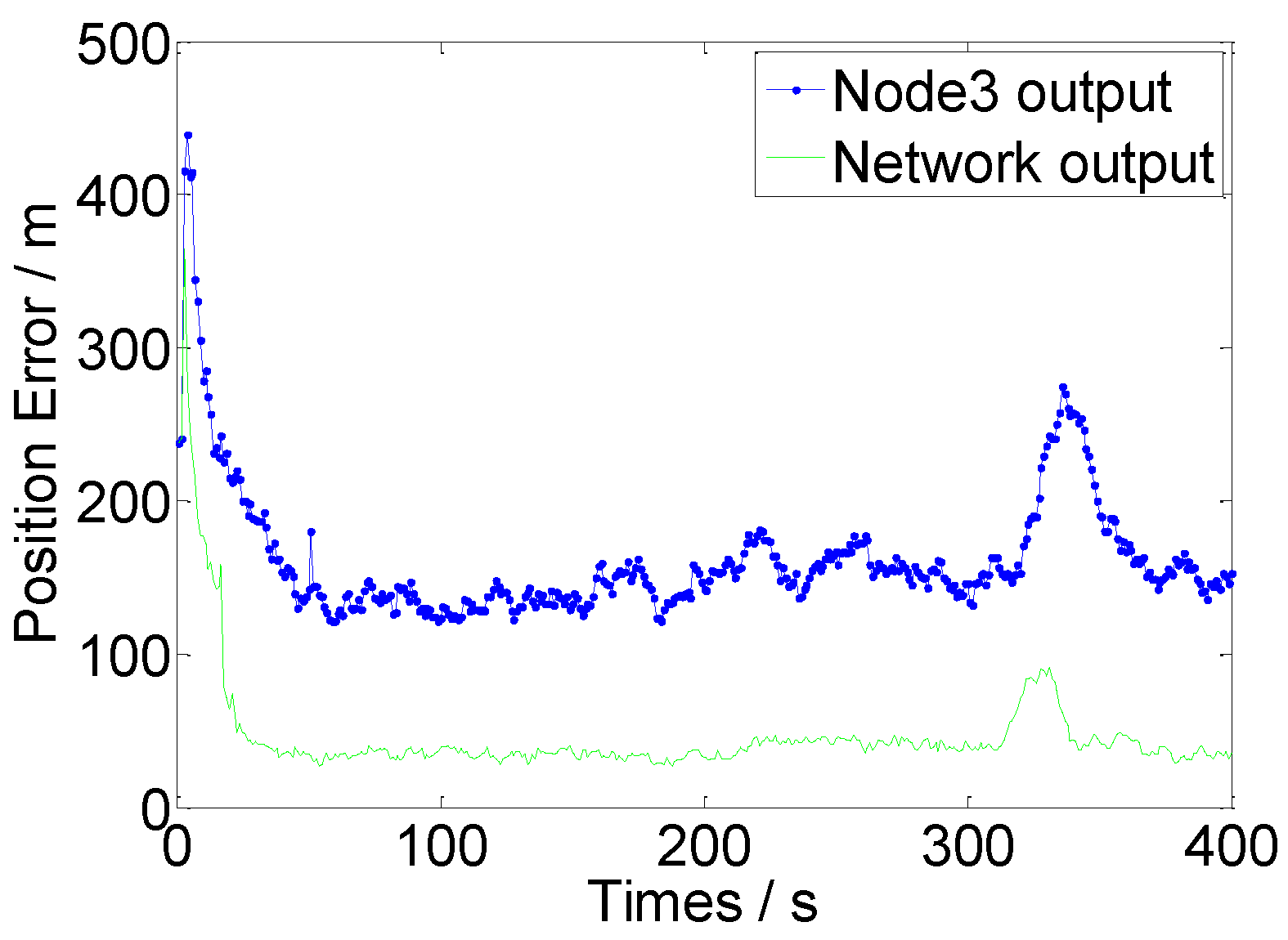
| Rj(i,i) | ZE | S | L | |
|---|---|---|---|---|
| EoRj(i,i) | ||||
| ZE | wij(k) = 1 | wij(k) = 1 | wij(k) = 0.5 | |
| S | wij(k) = 1 | wij(k) = 0.5 | wij(k) = 0 | |
| L | wij(k) = 0.5 | wij(k) = 0 | wij(k) = 0 | |
| Multi-Node Output of FNN–IMM | Single Node Output of FNN–IMM | |
|---|---|---|
| Average Position Error | 46.9680 | 162.6039 |
| Average Error of x axis | 34.6952 | 119.7772 |
| Average Error of y axis | 34.7728 | 120.1503 |
© 2016 by the authors; licensee MDPI, Basel, Switzerland. This article is an open access article distributed under the terms and conditions of the Creative Commons Attribution (CC-BY) license (http://creativecommons.org/licenses/by/4.0/).
Share and Cite
Sun, B.; Jiang, C.; Li, M. Fuzzy Neural Network-Based Interacting Multiple Model for Multi-Node Target Tracking Algorithm. Sensors 2016, 16, 1823. https://doi.org/10.3390/s16111823
Sun B, Jiang C, Li M. Fuzzy Neural Network-Based Interacting Multiple Model for Multi-Node Target Tracking Algorithm. Sensors. 2016; 16(11):1823. https://doi.org/10.3390/s16111823
Chicago/Turabian StyleSun, Baoliang, Chunlan Jiang, and Ming Li. 2016. "Fuzzy Neural Network-Based Interacting Multiple Model for Multi-Node Target Tracking Algorithm" Sensors 16, no. 11: 1823. https://doi.org/10.3390/s16111823






